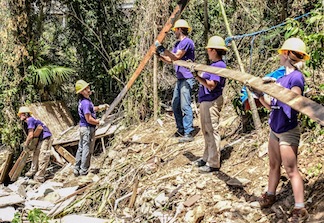The following is text of a news release from the State University of New York (SUNY) Maritime College:
(THROGGS NECK, N.Y.) — Early this summer in 90-degree heat, groups of volunteer SUNY Maritime students were busy scrambling up and down cliffs to take apart pieces of buildings that had been ripped off and blown away by hurricanes on St. John, U.S. Virgin Islands.
Nearly 30 students and one faculty adviser from SUNY Maritime College spent six weeks clearing debris, removing mold-infested materials and demolishing condemned homes on the island that was devastated by hurricanes Irma and Maria.
Each student signed up for a two-week assignment help ongoing recovery efforts after last year’s devastating hurricane season. Students spent most of their time removing pieces of destroyed homes and putting them into piles to be reused or thrown away. Others worked to remove walls and floors infected with black mold that had spread through once water-logged homes.
“Many of the homes we worked on were demolished and unrecognizable as homes, so our main objective was to deconstruct the pieces and move them into staged piles at the top of the road to prepare to take away,” said Shannon McSweeney, a sophomore marine operations major from Huntington, N.Y. “We fire-lined the materials up steep slopes, trying to remove as much of the debris as possible to prevent future projectiles during the upcoming hurricane season.”
The trip was organized by humanities Professor Chris McMillan and Austin Ford, a junior marine transportation major from Maryland. They partnered with All Hands and Hearts, a service organization that has been involved in recovery efforts in the U.S. and British Virgin Islands, Puerto Rico, Mexico, Texas and Nepal, among other places.
“In the summer of 2017, I worked in a Greek refugee camp and when I came back to Maritime, I wanted our students to have more opportunities to volunteer outside their local communities,” said McMillan, who has been working to organize an international service trip since last fall. “I started a club, Humans Helping Humans, and was lucky enough to get a dynamo, Austin Ford, to be president. Then the hurricanes came and our focus was on helping in Puerto Rico. Though we didn’t get to Puerto Rico, All Hands offered us work in St. John.
“Going to St. John was an eye-opener. I gained a new deep respect for our students because all of them became part of a community of veteran volunteers, and all of them took on difficult and dangerous work enthusiastically and without complaint. They came away from the experience changed, and that’s the point.”
The devastation in St. John was so intense because of the one-two punch of hurricanes Irma and Maria. Irma brought winds of more than 120 miles per hour, which blew out or severely weakened structures across the islands. Two weeks later, Maria’s winds and heavy rains compounded the damage, devastating more of the island’s structures and making everything still standing susceptible to black mold.
“You’re doing whatever you can to get the homeowner to the next step, which is rebuilding,” said junior international transportation and trade major Madison Burbol.
The first day on one site, Burbol, of Brookhaven, N.Y., was given a power drill and told to take apart a porch that had been blown off a house and slid down a hill. To get to the porch, she had to hack a path through the brush with a machete.
Some of the Maritime students were used to using power tools and other materials before the trip because of the hands-on experiences they receive through the college’s U.S. Coast Guard licensing program. The program educates and trains students to work on commercial ships and other marine vessels and is designed to pair with certain degrees at the college.
Over the course of the two weeks, students worked relentlessly on several sites and most of them slept in tents. The group woke up at around 6 every morning. The students and other volunteers headed out to their work sites at 7 a.m. in “a fleet of Jeep Wranglers with the music blasting,” according to Burbol. They worked for seven or eight hours every weekday, and another four hours on Saturday. During breaks, they explored the island that would have been paradise if not for the devastation, with iguanas and wild donkeys roaming the hills, and beaches of powder-soft sand, clear blue water and spectacular Caribbean views.
“I definitely went out of my comfort zone more than I thought I would. We were just dead at the end of the day,” Burbol said. “And we were around people who do this every day. The first three days, I was so tired I wanted to go home. But by the fifth day, I got it. I think my body got used to the work and I started to see the difference we made.”
This is the second hurricane recovery trip Maritime students have been part of this summer. Several hundred students assisted with recovery efforts in Puerto Rico, the first stop on the college’s annual summer sea term. The college’s training ship Empire State VI provided housing for approximately 30 students from SUNY Albany and SUNY College of Environmental Science and Forestry, who were also on the island to help with recovery efforts. The students from the three colleges were the first to participate in Gov. Andrew Cuomo’s New York Stands with Puerto Rico Recovery and Rebuilding Initiative.
Empire State VI, which is owned by the federal government but operated by the college, was sent to assist with the immediate recovery efforts in Florida and Puerto Rico following hurricanes Irma and Maria. From Sept. 14 to Oct. 24, 2017, the ship operated like a hotel, housing more than 5,000 disaster-relief workers from FEMA and other organizations.

